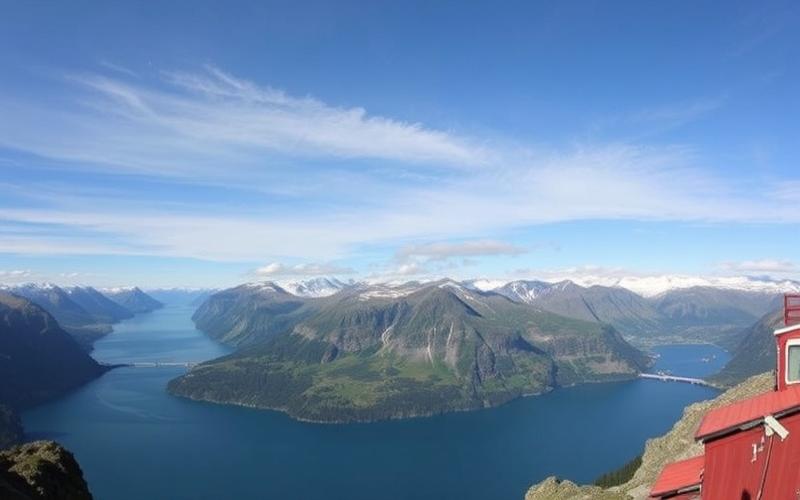
 Published on and written by Cyril Jarnias
Published on and written by Cyril Jarnias
Discovering a new country is an exciting adventure, and Norway, with its breathtaking landscapes and exceptional quality of life, attracts many expatriates every year.
However, finding housing in Norway can be challenging, especially for those unfamiliar with the local market.
This article provides practical tips and tricks for navigating the rental process, from understanding leases to the importance of inspections.
Whether you’re looking to live in the heart of Oslo or on the outskirts of the fjords, we’ll guide you to turn this challenge into a successful step in your relocation.
Finding Housing in Norway: Winning Strategies
Starting your housing search in Norway several weeks, or even months, before arrival is essential to maximize your chances, especially in major cities where demand is very high. Being responsive allows you to quickly view available properties and seize opportunities before they disappear.
Main Platforms to Use:
- Finn.no: The go-to site for all real estate listings, from studios to family homes.
- Hybel.no: Specializes in shared housing and small apartments, ideal for students and young professionals.
- Rubrikk.no: An aggregator that collects various market offers.
- Facebook groups and expatriate forums (for example, “Francophones in Norway”) often feature listings before they appear on traditional platforms.
Specific Strategies in Major Cities:
| City | Market Characteristics | Practical Tips |
|---|---|---|
| Oslo | High competition, expensive rents | Prioritize shared housing, target well-connected suburbs, prepare a strong application |
| Bergen | Tight market, strong seasonal demand | Use Finn.no and Hybel.no, consider student neighborhoods, local social networks |
| Others (Tromsø, Trondheim) | More affordable prices, limited offers | Aim for satellite towns or nearby suburbs, explore temporary options |
Shared housing is widespread in major cities and helps reduce costs while facilitating social integration. Housing in the suburbs or satellite towns is generally more affordable, with easy access to urban centers thanks to reliable public transportation.
Temporary Housing Options to Consider:
- Hostels: An economical solution for a smooth arrival.
- Short-term rentals (Airbnb, Guesthouse): Flexibility for searching for permanent housing on-site.
- University residences: Reserved for students, they offer a convenient setting and often all-inclusive rates.
Local and Digital Networking:
- Join expatriate groups or specialized forums to access exclusive offers and get recommendations on neighborhoods and procedures.
- Participate in local events, Meetups, or associations to expand your network and benefit from practical advice.
Documents to Prepare for Renting:
- Employment contract or proof of income.
- Pay stubs or bank statements.
- ID (passport, identity card).
- D-number (temporary identification number in Norway).
- Professional or rental references.
Financial Aspects to Anticipate:
| Element | Norwegian Practice | Important Notes |
|---|---|---|
| Security Deposit | Often 2 to 3 months’ rent | Deposited into a dedicated bank account |
| Utilities | Not always included in rent | Water, electricity, internet to verify |
| Agency Fees | If using an agency, expect 10% of rent | Option to consider if facing difficulties |
| Rent Payment | Automatic debit or bank transfer | Prepare a local bank card |
Essential Tip: Preparing a complete and well-organized application, being flexible about neighborhoods, and using multiple search channels are the keys to quickly finding suitable housing in Norway.
Negotiating rent or conditions is sometimes possible, especially for long-term rentals or if the property has been on the market for a long time. Finally, don’t hesitate to ask locals or established expatriates for advice to avoid pitfalls and optimize your efforts.
Good to Know:
To maximize your chances, start your search as soon as possible on Finn.no and Hybel.no, network with expatriates, and carefully prepare your documents like pay stubs; in Oslo and Bergen, consider temporary housing because demand is high there.
Planning the Right Budget for Housing in Norway
Average Rental Costs in Norway by City
| City | Studio / 1 Bedroom Downtown | 2 Bedrooms Downtown | 3 Bedrooms Downtown |
|---|---|---|---|
| Oslo | 12,000 to 15,000 NOK | 15,000 to 18,000 NOK | 18,000 to 25,000 NOK |
| Bergen | 10,000 to 13,000 NOK | 13,000 to 16,000 NOK | 15,000 to 20,000 NOK |
| Trondheim | 10,000 to 12,000 NOK | 12,000 to 15,000 NOK | 14,000 to 18,000 NOK |
Outside downtown, prices drop by 20 to 30% depending on size and location.
Additional Costs to Anticipate
- Utilities (water, heating, common area maintenance): Rarely included, budget 800 to 1,500 NOK/month depending on the apartment’s size and insulation.
- Electricity: 500 to 1,500 NOK/month (consumption varies by season, as heating is often electric).
- Internet: 400 to 600 NOK/month.
- Home Insurance: 100 to 200 NOK/month (highly recommended).
Ancillary Rental Fees
- Security Deposit: Typically 2 to 3 months’ rent.
- Agency Fees: Rare for individuals, but can represent 1 month’s rent if a real estate agent is involved.
- Room in shared housing in Oslo: 6,000 to 7,500 NOK/month.
- Room in shared housing in Bergen/Trondheim: 5,000 to 6,500 NOK/month.
- Shared housing significantly reduces monthly costs (rent, utilities, internet) and allows access to better-located or more spacious housing for the same budget.
Practical Tips to Reduce Housing Expenses
- Prioritize housing outside downtown: Rents 20 to 40% cheaper, with efficient public transportation in major cities.
- Shared housing: An economical and friendly solution, ideal for students or young professionals.
- Long-term rentals: Some landlords offer discounts for leases of one year or more.
- Monitor no-agency-fee offers on local platforms or through universities.
- Avoid furnished apartments, often more expensive, except for short stays.
- Compare utility costs (water, heating, electricity) included or not in the rent to better assess the total cost.
Estimated Minimum Monthly Income to Live Comfortably
For a single person wanting to rent a studio or a room in shared housing in Oslo:
| Expense Category | Amount (NOK) |
|---|---|
| Rent (shared housing/studio) | 6,500–12,000 |
| Utilities + electricity | 1,000–2,000 |
| Internet | 500 |
| Home insurance | 150 |
| Total Housing | 8,150–14,650 |
To live comfortably, it’s advised not to spend more than 30 to 35% of your income on housing. Thus, a minimum net monthly income of 25,000 to 35,000 NOK is recommended to cover all housing expenses and live decently, especially in Oslo. This threshold can be slightly lower in smaller cities or with shared housing.
Key Takeaways:
Shared housing and choosing housing outside downtown are the best strategies to significantly reduce your housing budget in Norway. Prioritizing long leases and comparing included utilities helps optimize your budget.
Good to Know:
Rents in Oslo can reach 15,000 NOK for a one-bedroom apartment, while in Bergen and Trondheim, they range from 10,000 to 12,000 NOK, not including utilities of 1,500 to 2,500 NOK; opting for shared housing or suburban housing can reduce these monthly costs.
Popular Neighborhoods Among Expatriates in Norway
Oslo, Bergen, and Trondheim are the most popular Norwegian cities among expatriates. Each offers sought-after neighborhoods for their quality of life, accessibility, and modern infrastructure.
| City | Popular Neighborhoods | Key Features | Average Rents (comparison) |
|---|---|---|---|
| Oslo | Frogner, Grünerløkka, St. Hanshaugen, Majorstuen | Proximity to transportation (tram, metro, bus), numerous international schools, rich cultural life, restaurants, museums, parks (Frogner Park), sports facilities, abundant green spaces | Highest in the country, led by Frogner and Majorstuen |
| Bergen | Sentrum, Sandviken, Nygård | Easy access to downtown, vibrant student life, proximity to the harbor, green spaces and mountains (Fløyen), dynamic art scene, reputable schools | Cheaper than Oslo, but high for Norway |
| Trondheim | Bakklandet, Moholt, Byåsen | Historic neighborhoods (Bakklandet), easy access to universities, numerous parks and bike paths, friendly atmosphere, quality schools, active social life | More affordable than Bergen and Oslo, especially Moholt |
Characteristics of Popular Neighborhoods:
- Proximity to Public Transportation: Central Oslo neighborhoods (Frogner, Grünerløkka, Majorstuen) offer immediate access to metro, tram, and bus lines. In Bergen and Trondheim, most sought-after neighborhoods are also very well-served, facilitating daily commutes.
- Quality of Schools and Services: Presence of renowned international and Norwegian schools, as well as modern daycare centers and medical facilities in these neighborhoods.
- Social and Cultural Life: Oslo offers theaters, museums (Munch, Astrup Fearnley), trendy restaurants and cafes, while Bergen charms with its festivals, music scene, and museums. Trondheim is appreciated for its student life and historic cafes.
- Modern Infrastructure: Recent housing, sports facilities, libraries, shopping centers, and coworking spaces are common in these areas.
- Green Spaces: Frogner Park (Oslo), City Park (Bergen), parks and trails along the Nidelva River (Trondheim) offer outdoor relaxation and recreation spots, highly valued by families and active expatriates.
Why These Aspects Attract Expatriates:
- The quality of life due to modern infrastructure and neighborhood cleanliness.
- Safety and friendliness, often cited as major assets.
- Access to urban nature rare in other European capitals.
- The richness of cultural life and ease of integration thanks to dynamic international communities.
Financial Aspects:
Average rents in Oslo are the highest in Norway, especially in central and upscale neighborhoods like Frogner and Majorstuen, where they often exceed 15,000 NOK/month for a two-bedroom apartment. Grünerløkka offers a compromise between vibrant life and slightly more affordable rents.
In Bergen, the city center (Sentrum) and Sandviken remain expensive but less so than Oslo. Shared housing is common among young professionals and students to limit costs.
In Trondheim, Moholt is particularly appreciated for its financial accessibility, while Bakklandet and Byåsen are more sought after for their charm and proximity to downtown, with prices remaining reasonable for a major Norwegian city.
Specific Neighborhood Examples:
- Frogner (Oslo): Chic residential neighborhood, very green, close to embassies and international schools, ideal for families and affluent expatriates.
- Grünerløkka (Oslo): Trendy, young, and cosmopolitan neighborhood, cafes, street art, independent shops, very lively on weekends.
- Sentrum (Bergen): Historic and commercial center, direct access to transportation, vibrant nightlife and cultural scene.
- Sandviken (Bergen): Seaside neighborhood, quiet and picturesque, appreciated for its authenticity.
- Bakklandet (Trondheim): Historic neighborhood with colorful houses, cafes by the river, bohemian atmosphere.
- Moholt (Trondheim): Proximity to universities, affordable housing, dynamic student life.
Good to Know:
Housing demand in these neighborhoods is strong, and shared housing is common, especially among young professionals and students, to reduce living costs while enjoying a high quality of life.
Summary of Main Advantages:
- Excellent accessibility (transportation, services)
- Green spaces and modern infrastructure
- Rich cultural and social life
- Safety and cleanliness
- High cost of living, especially in central neighborhoods, but justified by the quality of life offered
Good to Know:
In Oslo, Frogner is appreciated for its easy access to transportation, good schools, and green spaces, while in Bergen, Sandviken attracts for its vibrant cultural life and modern infrastructure; in Trondheim, Bakklandet offers a friendly experience with generally more affordable rents than other major cities.
Disclaimer: The information provided on this website is for informational purposes only and does not constitute financial, legal, or professional advice. We encourage you to consult qualified experts before making any investment, real estate, or expatriation decisions. Although we strive to maintain up-to-date and accurate information, we do not guarantee the completeness, accuracy, or timeliness of the proposed content. As investment and expatriation involve risks, we disclaim any liability for potential losses or damages arising from the use of this site. Your use of this site confirms your acceptance of these terms and your understanding of the associated risks.




















